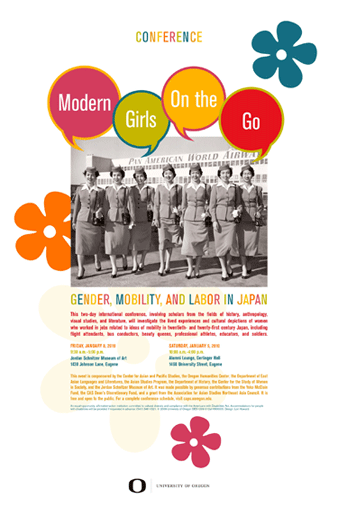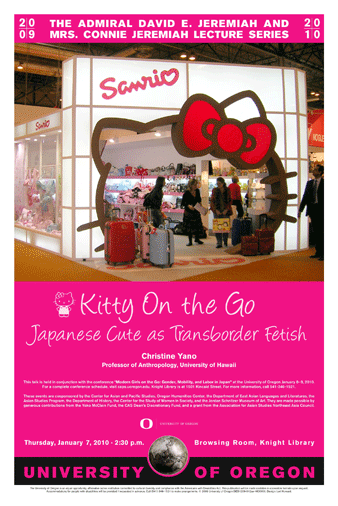“Modern Girls on the Go: Gender, Mobility, and Labor in Japan” (MGG)
University of Oregon This international workshop, involving scholars from the fields of history, anthropology, visual studies, and literature, will investigate the lived experiences and cultural depictions of women who worked in jobs related to ideas of mobility in twentieth and twenty-first century Japan, including flight attendants, tour bus guides, beauty queens, professional athletes, educators, and soldiers. These women, often conspicuous in their uniforms, have influenced gender norms, patterns of daily life, and Japan’s international image. They have been an integral and highly visual part of the national workforce but have been overlooked by scholars. They performed jobs that were considered fashionable in their first inception and therefore represented ideas of modernity at different historical moments. These laborers show the important relationship between gender, modernity, and technology.
This international workshop, involving scholars from the fields of history, anthropology, visual studies, and literature, will investigate the lived experiences and cultural depictions of women who worked in jobs related to ideas of mobility in twentieth and twenty-first century Japan, including flight attendants, tour bus guides, beauty queens, professional athletes, educators, and soldiers. These women, often conspicuous in their uniforms, have influenced gender norms, patterns of daily life, and Japan’s international image. They have been an integral and highly visual part of the national workforce but have been overlooked by scholars. They performed jobs that were considered fashionable in their first inception and therefore represented ideas of modernity at different historical moments. These laborers show the important relationship between gender, modernity, and technology.
The workshop will open with a keynote talk by Professor Christine Yano (University of Hawaii) on “Kitty on the Go: Japanese Cute as Transborder Fetish.” In conjunction with MGG, the Jordan Schnitzer Museum of Art will hold an exhibit of Toshiko Okanoue’s original collages and a selection of photo-lithographs from “The Miracle of Silence,” a 2007 Nazraeli Press publication, along with woodblock prints of workingwomen. A full conference schedule will be available at the Center for Asian and Pacific Studies website (caps.uoregon.edu).
MGG is free and open to the public. For more information, please contact Alisa Freedman (alisaf@uoregon.edu). This event is being co-sponsored by the Center for Asian and Pacific Studies, Department of East Asian Languages and Literatures, Oregon Humanities Center, Jordan Schnitzer Museum of Art, Center for the Study of Women and Society, History Department, Asian Studies Program and is made possible by generous contributions from the McClain Fund, College of Arts and Sciences Deans Discretionary Fund, Jeremiah Speaker Fund, and the Northeast Asia Council.
 Thursday, January 7, 2010: Knight Library Browsing Room
Thursday, January 7, 2010: Knight Library Browsing Room
2:30 Christine Yano, University of Hawaii, “Kitty on the Go: Japanese Cute as Transborder Fetish”
7:00 Public screening of "Even So, I Just Didn’t Do It" (Sore demo, boku wa yattenai, Suo Masayuki, dir., 2006) as part of the “New Japanese Cinema, IV: Justice and Truth” series (every Thursday from 7-10:00, Lillis 282. I would be glad to provide information on the 10 series films.)
Friday, January 8, 2010: Jordan Schnitzer Museum of Art, 9:30-5:00
9:30-9:45 Short opening remarks9:45-11:00 Panel 1: Department Stores as Sites of Mobility 1. Elise K. Tipton, University of Sydney, “Moving Up and Out: The ‘Shop Girl’ in Interwar Japan” 2. Laura Miller, Loyola University Chicago, “Elevator Girls Moving In and Out of the Box”
11:00-11:15 Coffee break
11:15-12:30 Panel 2: Beauty Work and Japan’s Global Appearance 3. Vera Mackie, University of Melbourne, “Shiseidô and the Mobile Modern Girl” (presented in absentia) 4. Jan Bardsley, University of North Carolina at Chapel Hill, “Beauty Queens on the Go: Miss Japan and the Somatic Uniform”
12:30-2:30 Lunch break and time in Jordan Schnitzer Museum of Art
2:30-4:00 Panel 3: Models and Modes of Transportation 5. Christine Yano, University of Hawaii, “‘Flying Geisha’: Japanese Stewardesses as Postwar Modern Girls” 6. Alisa Freedman, University of Oregon, “Bus Guides Tour National Landscapes, Pop Culture, and Youth Fantasies” 7. Christopher Hood, University of Cardiff, “Fast Women: The Shinkansen and Changing Japanese Gender Roles” (presented in absentia)
4:00-4:15 Coffee break
4:15-5:00 Day’s Closing Remarks and Discussion – Jeff Hanes, University of Oregon
Saturday, January 9, 2010, 10:00-4:00, Alumni Lounge, Gerlinger Hall
10:00-12:00 Panel 4: Overturning Gender and Class 8. Sabine Frühstück, University of California, Santa Barbara, “Girl Power: Female Soldiers in the Self-Defense Forces” 9. Elise Edwards, Butler University, “The Ladies League and Corporate Futures: Envisioning an ‘Epoch Change’ Through Female Soccer Success” 10. Barbara Sato, Seikei University, “Modern Culture and Working-Class Women”12:00-1:30 Lunch break
1:30-3:00 Panel 5: Japanese Educators and Students in the United States 11. Sally A. Hastings, Purdue University “Traveling to Learn: Tsuda University Students in the United States, 1900-1941” 12. Yoko McClain, University of Oregon, speaking on her experiences as a modern girl on the go.
3:00-3:15 Coffee break
3:15-4:00 Day's Closing Remarks and Discussion – Carol Stabile, University of Oregon
“Kitty on the Go: Japanese Cute as Transborder Fetish,” Christine Yano, University of Hawaii
Hello Kitty, that ubiquitous mouthless icon of Japanese Cute, provides a good case study of the methodological and interpretive issues of globalization. The semantic slate of Hello Kitty is both blank and filled with national-cultural meaning. It is this particular kind of straddling of non-meaning and meaning that allows her interpretation as what I call a “transborder fetish.” Here, I borrow the notion of border fetishism from the field of religious studies to reference the hyper-spectacle both within and of the border. However, I push the notion of border fetish further to examine ways in which this product transcends category specificity through the multiple meanings bestowed by consumers globally. With the intensity of the global gaze pushed to new arenas of high-ticket consumption, Hello Kitty becomes the site of ubiquity that crosses borders: cheap and luxurious, innocent and sexy, child and adult, Japan and mukokuseki (no nationality). It is this very transborder quality of the product that makes Hello Kitty not only a marketer’s dream, but also an anthropologist’s challenge.Okanoue Toshiko’s Collages, Gilkey Center, Jordan Schnitzer Museum of Art
In conjunction with the conference “Modern Girls on the Go: Gender, Mobility and Labor in Japan” the JSMA is exhibiting a couple of Toshiko Okanoue’s original collages and a selection of photo-lithographs from The Miracle of Silence, a 2007 Nazraeli Press publication. Toshiko Okanoue’s youth was seized by war and a consequence of destruction was reconstruction during the 1950s that included cultural centers and institutions and new museums and galleries. Innovative musicians, writers and visual artists paved the way for a new era of avant-garde artists. A year after Toshiko Okanoue graduated from the Ogawa Fashion Institute in 1949 she began studies in fashion illustration at Bunka Gakuin College. Lacking confidence in her drawing skills she began cutting and pasting images from American magazines such as Vogue and Life. In 1953 these early collages were exhibited at Takemiya Gallery, Tokyo. Art critic Shuzo Takiguchi’s gallery introduction to her work notes “Miss Okanoue is not a painter; she is a young lady. Working by herself she cuts up illustrated magazines to make collages that depict her very dreams. The resulting album is a contemporary version of Alice in Wonderland. Please come and see for yourself.See related articles: “Girls in Motion,” “Changing Images of Japanese Workingwomen” and CSWS Noon Talks: Alisa Freedman.

